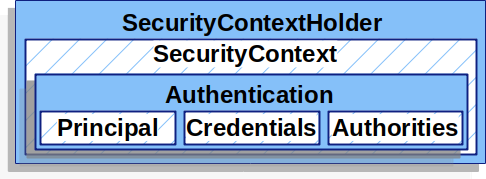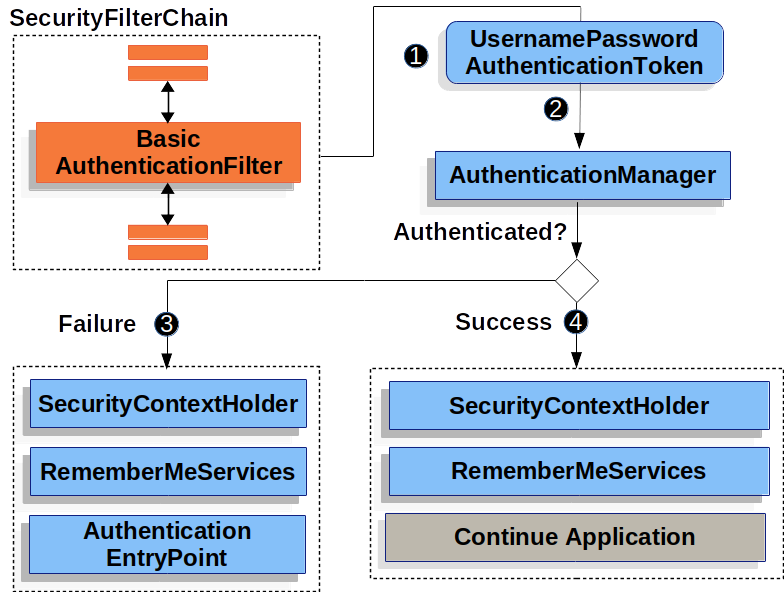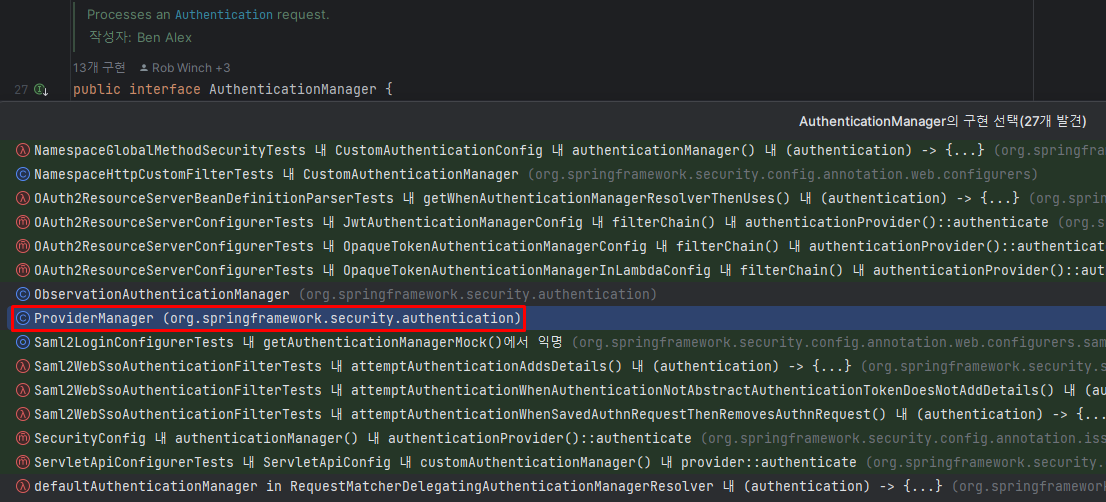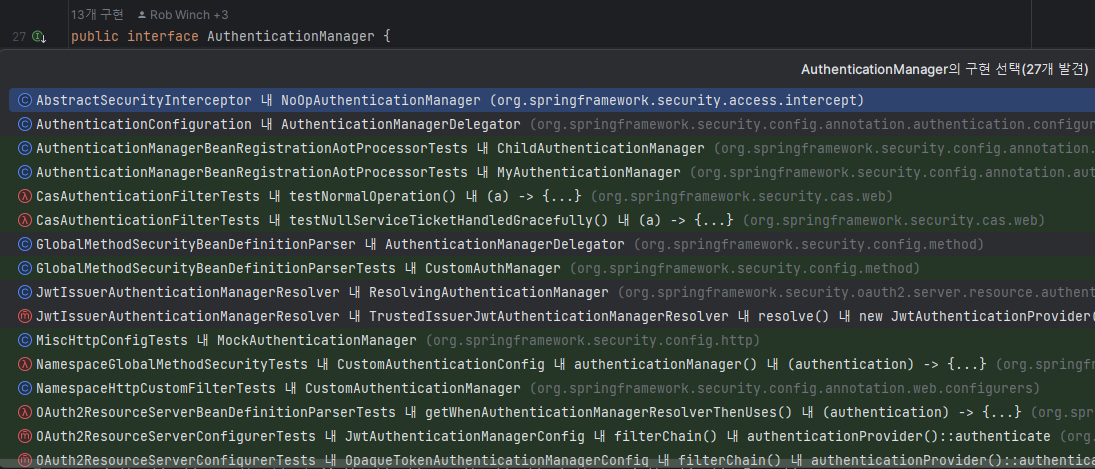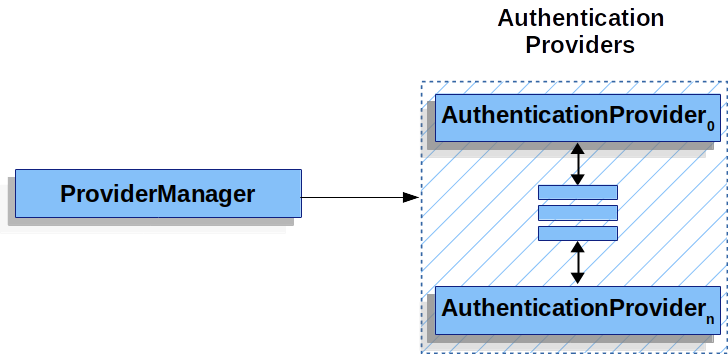Spring Security (8) AuthenticationManager
Intro
이전 글에서 SecurityContext, Authentication, GrantedAuthority를 살펴봤고, 이어서 공식 문서(링크) 순서대로 AuthenticationManager 부터 살펴보겠습니다.
AuthenticationManager
이전 글에서 AuthenticationManager는 인증 절차를 수행하겠구나… 하면서 넘어갔습니다.
문서 살펴보기
공식 문서(Servlet Authentication Architecture)의 가장 상단에 나온 한 줄짜리 설명에는 이렇게 나옵니다.
the API that defines how Spring Security’s Filters perform authentication.
Spring Security의 Filters가 인증을 수행하는 방법을 정의하는 API입니다.
AuthenticationManager interface API 문서에도 아주 간단하게 설명합니다.
Processes an
Authenticationrequest.
Override 할 메서드가 한 개 밖에 없어서, 그대로 붙여넣겠습니다.
| Modifier and Type | Method | Description |
|---|---|---|
| Authentication | authenticate(Authentication authentication) | Attempts to authenticate the passed Authentication object, returning a fully populated Authentication object (including granted authorities) if successful. |
메서드 설명을 보면, 전달된 Authentication 객체(이전 글에서 봤던 Token들)의 인증 시도 후 성공하면 완전히 채워진 Authentication 객체(부여된 권한 포함)를 반환한다고 써있습니다.
완전히 채워진(fully populated)의 의미가 잘 와닿지는 않습니다. Authentication 객체의 주요 목적 중 하나가 사용자가 인증을 위해 제공한 credentials를 AuthenticationManager의 입력으로 제공 하는 것이라는 이전의 정보(링크)를 바탕으로 추측해보면 Principal과 Credentials 를 바탕으로 인증을 수행하고, Authorities 를 채워넣는다는 의미라고 보면 되겠습니다.
이미 문서에서 한 줄로 정리했지만, 다시 또 정리해 보자면 AuthenticationManager는 어떻게 인증할 것인지 정의한다고 할 수 있겠습니다.
그리고 공식 문서의 AuthenticationManager 섹션(링크)을 보면, 아래와 같이 AuthenticationManager 가 필요한 경우와 필요 없는 경우를 설명하고 있습니다.
The
Authenticationthat is returned is then set on the SecurityContextHolder by the controller (that is, by Spring Security’sFiltersinstances) that invoked theAuthenticationManager. If you are not integrating with Spring Security’sFiltersinstances, you can set theSecurityContextHolderdirectly and are not required to use anAuthenticationManager.
controller(Spring Security의 Filters 인스턴스)에 의해서 SecurityContextHolder에 Authentication 이 저장되는 경우에는 AuthenticationManager가 호출되고 사용되지만, 개발자가 직접 SecurityContextHolder에 Authentication을 저장하는 경우에는 사용할 필요가 없다고 합니다.
이전에 본 Filters 살펴보기
이전에 봤던 Filters 중에 Auhtentication 이 붙은 Filter가 문서에서 말하는 Controller라고 보면 되겠습니다. 아래 DefaultSecurityFilterChain 로그에서는 UsernamePasswordAuthenticationFilter, BasicAuthenticationFilter, AnonymousAuthenticationFilter 가 보입니다.
1
2
3
4
5
6
7
8
9
10
11
12
13
14
15
2023-07-08T20:25:11.740+09:00 INFO 18352 --- [ main] o.s.s.web.DefaultSecurityFilterChain : Will secure any request with [org.springframework.security.web.session.DisableEncodeUrlFilter@4fe533ff,
org.springframework.security.web.context.request.async.WebAsyncManagerIntegrationFilter@5377414a,
org.springframework.security.web.context.SecurityContextHolderFilter@1ee47d9e,
org.springframework.security.web.header.HeaderWriterFilter@340d6d89,
org.springframework.security.web.csrf.CsrfFilter@1b2df3aa,
org.springframework.security.web.authentication.logout.LogoutFilter@7978e022,
org.springframework.security.web.authentication.UsernamePasswordAuthenticationFilter@15f35bc3,
org.springframework.security.web.authentication.ui.DefaultLoginPageGeneratingFilter@2e766822,
org.springframework.security.web.authentication.ui.DefaultLogoutPageGeneratingFilter@4e83a98,
org.springframework.security.web.authentication.www.BasicAuthenticationFilter@20a7953c,
org.springframework.security.web.savedrequest.RequestCacheAwareFilter@5dc0ff7d,
org.springframework.security.web.servletapi.SecurityContextHolderAwareRequestFilter@13dbed9e,
org.springframework.security.web.authentication.AnonymousAuthenticationFilter@17aa8a11,
org.springframework.security.web.access.ExceptionTranslationFilter@480b57e2,
org.springframework.security.web.access.intercept.AuthorizationFilter@76a805b7]
BasicAuthenticationFilter
BasicAuthenticationFilter는 간단하게 다루기도 했었습니다(링크). 다이어그램을 다시 잠깐 보면, 위에서 controller라 칭하는 BasicAuthenticationFilter 가 Authentication 객체인 UsernamePasswordAuthenticationToken 을 AuthenticationManager 객체를 호출하면서 입력으로 제공합니다. 그리고 이제 AuthenticationManager 에서 Token을 어떻게 처리하는지 보려고 하고 있는 것입니다.
Filter의 doFilterInternal 메서드에서 AuthenticationManager 에 인증을 요청하는 것을 볼 수 있습니다.
1
2
3
4
// BasicAuthenticationFilter.java
if (authenticationIsRequired(username)) {
Authentication authResult = this.authenticationManager.authenticate(authRequest);
SecurityContext context = this.securityContextHolderStrategy.createEmptyContext();
AnonymousAuthenticationFilter
AnonymousAuthenticationFilter는 인증할 정보가 없으니 바로 Authentication 객체를 SecurityContext에 저장하기는 합니다.
1
2
3
4
5
6
7
8
9
10
11
12
13
14
15
16
17
18
19
20
21
22
23
// AnonymousAuthenticationFilter.java
private SecurityContext defaultWithAnonymous(HttpServletRequest request, SecurityContext currentContext) {
Authentication currentAuthentication = currentContext.getAuthentication();
if (currentAuthentication == null) {
Authentication anonymous = createAuthentication(request);
if (this.logger.isTraceEnabled()) {
this.logger.trace(LogMessage.of(() -> "Set SecurityContextHolder to " + anonymous));
}
else {
this.logger.debug("Set SecurityContextHolder to anonymous SecurityContext");
}
SecurityContext anonymousContext = this.securityContextHolderStrategy.createEmptyContext();
anonymousContext.setAuthentication(anonymous);
return anonymousContext;
}
else {
if (this.logger.isTraceEnabled()) {
this.logger.trace(LogMessage.of(() -> "Did not set SecurityContextHolder since already authenticated "
+ currentAuthentication));
}
}
return currentContext;
}
다시 문서로
다음으로 문서에 AuthenticationManager 에 관하여 써있는 마지막 문장을 보면 아래와 같습니다.
While the implementation of
AuthenticationManagercould be anything, the most common implementation isProviderManager.
AuthenticationManager의 구현은 무엇이든 될 수 있지만, 가장 흔한 구현은 ProviderManager 라고 합니다.
Intellij 로 보면, ProviderManager 도 보이고, 다양한 AuthenticationManager 구현이 있지만 Test 내부에 있는 것이 많이 보입니다.
Test 외에도 여러 Parser, Resolver 등 클래스의 내부 클래스로 구현된 것들을 볼 수 있습니다.
ProviderManager 를 사용하지 않는 구현들은 각 개별적인 상황이 필요할 때 살펴보면 될것 같고, 문서 순서대로 ProviderManager를 봐야하는데… 문서를 보니 내용이 길어질 것 같아 예고편 마냥 맛만 보고 가겠습니다.
ProviderManager
공식 문서(링크) 첫 문단에 있는 문장 중에는 아래와 같이 ProviderManager는 AuthenticationProvider 인스턴스의 목록에 위임한다고 합니다.
ProviderManagerdelegates to aListofAuthenticationProviderinstances.
마치 SecurityFilterChain 내에 여러 Filter가 순서대로 처리되는 것과 같은 패턴으로 보입니다.
Outro
ProviderManager는 정말 맛만 보고 마무리 합니다. Servlet Authentication Architecture 내용을 언제 다 보나 했는데, 섹션 기준으로는 벌써 절반을 넘겼습니다(9개 중에 5개). 다음에는 맛만 본 AuthenticationManager의 구현 중 하나인 ProviderManager를 살펴보겠습니다.
